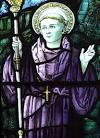St Cybi and St Elizabeth of the Trinity

St Cybi of Anglesey
Abbot. This 6th century saint founded a monastery in Holyhead, Anglesey. Together with his friend Seiriol, Saint Cybi is regarded as the most important saint from the island. There are numerous dedications to Cybi throughout Wales and in Cornwall too - including a well at Llangybi near Gwynedd and a half-ruined beehive cell. St Cybi's well is still used for baptism and healing to this day.
A dedication at Llangiby on Usk describes him as a Cornish saint who travelled by river and sea and lived as a hermit.
According to his Life, written in the 13th century, he made a pilgrimage to Jerusalem where he stayed with St Hilary. Later he was made bishop and travelled to Ireland via Meneva, before settling in Anglesey. The Welsh prince Maegwn Gwnedd of Cunedda is said to have given him the site for his monastery. The remains on Anglesley are quite unusual, being a Christian church built within the enclosure of a Roman fort, probably a coastguard station.
and St Elizabeth of the Trinity
Elizabeth of the Trinity is the Carmelite's newest Saint, canonised by Pope Francis in 2016.
The Carmelite Nuns in Britain write: Elizabeth Catez was born on 18 July 1880 at a military camp near Bourges, the first child of Joseph Catez, an army captain and his wife Marie (née Rolland). In February 1883 their second daughter, Marguerite (Guite) was born, shortly after the small family moved to Dijon in eastern France. Elizabeth's father died of a heart attack when she was just seven years old.
A lively child with a strong temperament., Elizabeth loved music and was a gifted pianist, winning conservatory prizes. She could have made a career as a concert pianist. However, her desires were already leading her in a very different direction: towards giving herself to Christ in a life of prayer. She first spoke of wanting to be a nun at the age of seven. Her mother would not hear of it, and continued to oppose Elizabeth's vocation as she grew older, forbidding her to visit the Carmel of Dijon. Elizabeth's prayer life continued to deepen and she was one of the first to read the autobiography of St Thérèse of Lisieux. Finally, when Elizabeth was nineteen years old, her mother reluctantly agreed that she could enter Carmel when she turned 21.
On 2 August 1901 Elizabeth entered the Carmel of Dijon. Her early letters to her mother and Guite show that she was acutely aware of the pain her decision had caused them. Elizabeth on the other hand was blissfully happy to be in Carmel and invited her mother and sister to try to be happy for her. The community were delighted with their new postulant and sent a photograph to the Lisieux Carmel with this prophetic note: "A postulant of three days but one who has desired Carmel since the age of seven, Sr Elizabeth of the Trinity, who will turn out to be a Saint, for she already has remarkable dispositions for that."
Elizabeth was already a contemplative before she entered Carmel. Now she discovered the works of St John of the Cross and some writings by the Rhineland mystics, notably John Ruysbroeck, which led her deeper into the mystery of the divine.
Elizabeth was convinced that anybody could practice contemplative prayer. She was unusually ahead of her time in an age when most people considered contemplation to be the preserve of monks and enclosed nuns.
Her letters are full of wise counsel for those wishing to combine contemplative prayer with a busy lifestyle. She made notes during the last two retreats of her life especially to help her sister Guite, who by that time had two small children.
As a last testament, she left a letter for her Prioress Mother Germaine with the recurring message: "Let yourself be loved."
Elizabeth's best known written work is her beautiful prayer to the Trinity, "O my God, Trinity whom I adore" which is also an act of self-offering. It is a rich tapestry of contemplative spirituality and includes phrases borrowed from St Thérèse, Ruysbroeck and Elizabeth's own spiritual director Père Irénée Vallée OP. Elizabeth wrote it on 21 November 1904 after the community had renewed their religious vows.
Elizabeth's message is that God dwells within each one of us, and we can find Him there in each present moment. This also brings us into communion with one another, a communion which transcends all distance, and even death.
Not long before she died, Elizabeth wrote: "I think that in heaven my mission will be to draw souls by helping them to go out of themselves in order to cling to God in a wholly simple and loving movement, and to keep them in this great silence within, which will allow God to communicate Himself to them and to transform them into Himself."
Only four years after entering Carmel, Elizabeth's health began to decline with Addison's disease, which at the time was incurable.
She died on 9 November 1906. She was beatified by Pope John Paul II on 25 November 1984 and canonised by Pope Francis on 16 October 2016. Her eldest niece Elizabeth followed in her aunt's footsteps and entered the Dijon Carmel, also taking the name Elizabeth of the Trinity. She died in 1991.
For more information on St Elizabeth of the Trinity, (and some lovely photographs) visit her official website: www.Elisabeth-dijon.org/en/
For reflections and the Carmelite proper Divine Office for Elizabeth's feast day, visit: https://carmelitequotes.wordpress.com/
Read more about the Carmelite Nuns in Britain: https://carmelitenuns.uk/












